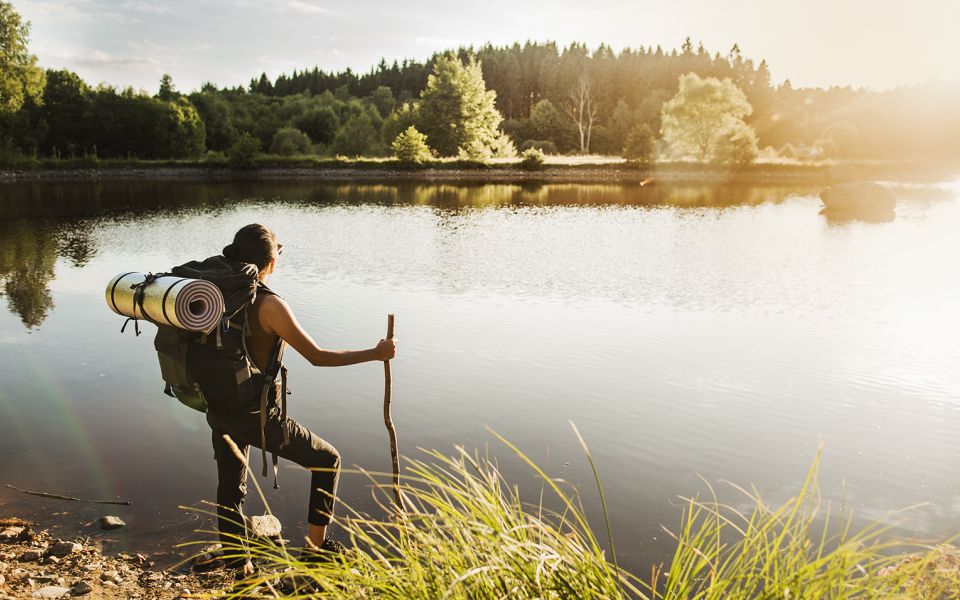9 Heinge - Lövestads åsar
-
Length
6 km
-
Degree of difficulty
Red
This short section of trail in the interior of southeast Skåne is all about stone. Along paths and small roads, you pass stone fences, clearance cairns in ancient pastures, an esker network of small stones, and a collection of stone blocks, lovingly sculpted and engraved with spiritual texts. Here, humans have struggled with the stony remains of the last ice age for centuries.
Nature
Your starting point is the Heinge campsite with its view over the beech woodland and the valley below. From here, winding paths just next to a ravine lead you through the grazed woodland in the Heinge Recreation Area. The blackthorn and hawthorn have been shaped by grazers, and in spring, liverwort flowers profusely. Near the creek, you can find the tall slender meadow rue, with its lacy blueish-green foliage and dense fluffy flowers. The rare yellow pimpernel also grows here.
Following small roads, you soon reach the esker system that is Lövestads Åsar. These eskers are unique in Skåne as they consist of a network of alternating basins and ridges in the south, and a single esker to the north. Lövestads Åsar are the result of extensive glacial melt at the end of the last ice age some 15,000 years ago, when the melt waters forced their way through tunnels, depositing gravel and stones in long ribbons, and a few boulders in the northern part of the system. The footpath to the campsite takes you through an unusually species rich beech woodland. Keep an eye out for yellow archangel, or the aluminium plant as it is sometimes called, and snails and bats. At the campsite, you pitch your tent in one of the basins between eskers.
Cultural History
Take some time to explore the Heinge Recreation Area at the beginning of the trail, with its ancient agricultural landscape with mixed nature and stones wherever you look. Large rocks protrude from the grazed pastures, and there are many stone walls and clearance cairns by the ancient fields, indicating the land was cultivated for centuries before being abandoned.
Don’t miss Hallsberg Gård, a farmhouse and outbuildings from the 1800s, with a collection of oddly shaped stone figures with engraved texts in the garden. They were created during the late 1800s by Nils Nilsson. He had probably collected the oddly shaped stones over a whole life time of struggling to clear rock from his fields. He spent his last 20 years painstakingly smoothing and chiselling the stone blocks into what you see today. A deeply religious man, who suffered the loss of seven of his nine children, his sorrow and faith are reflected in the spiritual texts he engraved, and the beautiful garden he planted where they stand. The buildings themselves are also a part of the museum, with many authentic carpentry tools, horse-drawn carriages, and much more, all undoubtedly used by Nils and his family in the 1800s.
The wide path up to the summit of Lövestads Åsar is an ancient route. Just like in so many other places, people chose to travel along the top of the ridge to stay dry and for the view. Lövestads Åsar was once common land where the villagers grazed their animals. East of the campsite at Lövestads Åsar are the foundation stones from a spinning house and to the southeast another memorial stone made by Nils Nilsson, the Massastenen – The Massa Stone. The stone was ordered by the local vicar Gussenius, known for his extravagant lifestyle and fondness for drink. One day he invited the high sheriff and other municipals clerks to join him on a walk, where he had hidden a keg. He struck the ground with his staff and magically produced aquavit – the water of life – flavoured potato vodka. The entire incident was a play on a couple of versus from the Bible (Exodus 17, verses 5-7) where Moses strikes a rock with his staff in front of the tribal elders and water flows for the thirsty Israelites to drink. Moses named this place Massah, and the memorial stone inscription is a reference to this episode and place.
6 km
About Difficulty Grading
The grading is tailored for Swedish lowland trails that adhere to the quality criteria established by the national framework for hiking trails.
Even and firm ground: The terrain is generally flat. The hike requires no need to use your hands for support. No obstacles. Bridges are always present when crossing waterways.
Uneven and/or soft ground: Some changes in elevation. Certain sections may require hand support to maintain balance. There may be obstacles such as low stiles and short stairs. Minor obstacles like stones and roots. Boardwalks are present.
Loose or slippery ground combined with steep sections: Technical parts require hand support. There may be obstacles such as high stiles and longer stairs. Frequent sections with stones and/or roots. Boardwalks with deeper surrounding water.
Note: One or more of these features may be present along the trail section.
Red
1,5-2 timmar
- Skog
- 1-7 km
- Medel
- Barnfamiljer
- Skåneleden
Highlights along the section
Are you looking for a place to stay or a cozy cafe during your hike? Here are some of the sights and places to visit along the section.
Hiking suggestions
Do you find it difficult to know where to start your hike? Here is some inspiration and a selection of recommended hikes - short and long, with or without accommodation or based on different themes.
Show allNews
Here you will find information about what's new on the trail as well as current redirections and disturbances.
Continue on the trail
Previous section
Next section
Share your moments
Share your adventures on the trail by tagging your photos with #skåneleden or #skaneleden.

